
Renewable diesel turns out, somewhat to my surprise, to be the real deal. It is a true hydrocarbon, identical with diesel fuel but made from biomass, with a lower carbon footprint and better performance. The carbon intensity of renewable diesel is about one-third that of the regular diesel sold in California (36 vs 100 gCO2e/MJ). Furthermore, renewable diesel does not need to be blended with a petroleum product, as is typical for ethanol and biodiesel (1). You can get it straight out of the pump.
Is it too good to be true? It does cost more to produce, but in California the petroleum producers subsidize it through the Low Carbon Fuel Standard (LCFS), resulting in reasonable consumer prices.

Renewable diesel is sold on San Antonio Avenue in Palo Alto
If you are driving a diesel car or truck, I would absolutely recommend using renewable diesel. You can find it at several stations in our area (2). But there are a few caveats to keep in mind:
- The carbon intensity of renewable diesel can vary depending on how it’s made. It can be as low as 20 gCO2e/MJ or as high as 60, and you don’t know which process was used for the fuel at a given station.
- The carbon intensity is likely to increase as more renewable diesel is produced because we will run short of the lower-carbon feedstocks such as used cooking oil. The graph below shows a 15% or so increase in the past 4-5 years.

The carbon intensity of renewable diesel has increased from 30 to 36 in the last four years. Source: LCFS quarterly data spreadsheet, 2021
- Electric vehicles running on California’s grid electricity have even lower emissions intensity (24 gCO2e/MJ), and will continue to get lower as the grid gets cleaner. So don’t let the promise of renewable diesel keep you from getting an electric vehicle.
If you are interested in more background, keep on reading. You’ll find a quick overview of the Low Carbon Fuel Standard program, which is what enables these alternative fuels to gain traction in California. Then I’ll go over how carbon intensity is assessed and why it can vary so much.
What is the Low Carbon Fuel Standard?
The Low Carbon Fuel Standard is a California program designed to reduce the carbon intensity of transportation fuel. It sets decreasing targets each year. Manufacturers and importers of fuel with carbon intensity greater than the target need to either earn or purchase credits, while manufacturers or importers of fuel with lower carbon intensity earn credits that they can then sell.
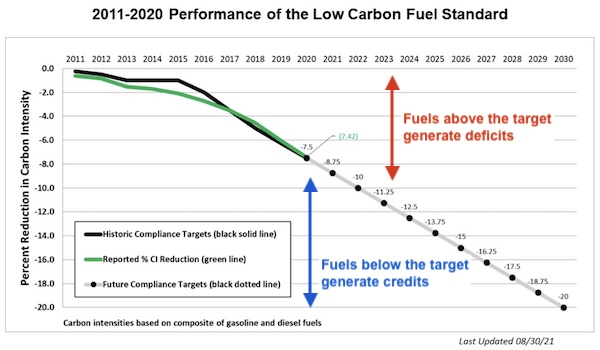
The Low Carbon Fuel Standard sets decreasing targets for carbon intensity each year. Source: LCFS overview, 2020
The price for a credit has been about $190 for the past few years. That translates to around $1.30 per gallon for a typical renewable diesel fuel, an amount that is paid for by producers of higher-emission fuel. This explains why Phillips 66, Valero, BP, and others are developing and marketing renewable diesel almost exclusively in California, though some other states are beginning to adopt similar policies.
The LCFS program applies to many types of transportation fuel, not just liquids. So, for example, our local power providers get credits for providing electricity (“fuel”) for EVs, with extra-credit for their cleaner power. They then sell these credits to polluters and use the funds to promote EV adoption. Anyone who owns an EV in our area is indirectly helping more people to adopt EVs because our power providers participate in this program.
The Low Carbon Fuel Standard has been very effective at helping California to reduce its emissions. In 2019, diesel fuel with bio-components (biodiesel and renewable) constituted 27% of total on-road diesel sold in California, up from 18.5% in 2018 and just 0.5% in 2011. The California Air Resources Board (CARB) estimates that liquid alternative fuels like renewable diesel, ethanol, and biodiesel have replaced over 650 million gallons of petroleum fuel just in 2020. Without biofuels, California’s tailpipe fossil CO2 would have been 10% higher in 2019. As a result, the program has won widespread acceptance after a very rocky start involving a “barrage of lawsuits.… The LCFS did not seem destined for greatness, never mind survival,” as Daniel Sperling and Colin W. Murphy write for Forbes.
What is Renewable Diesel?
What goes into one of these alternative fuels? The manufacture of renewable diesel starts with a fat such as used cooking oil, tallow, or inedible corn oil.
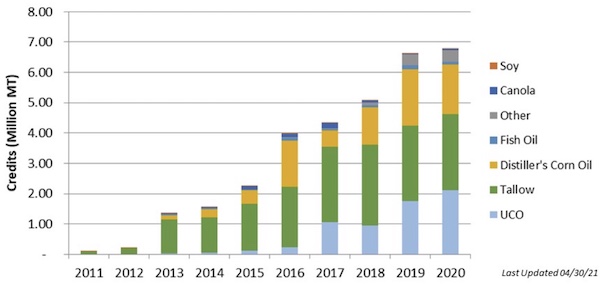
Crops and residues used in biomass-based diesel production. UCO stands for Used Cooking Oil. Source: LCFS dashboard, 2021
The oil is processed with high pressure and/or heat to remove impurities and water, then refined into a hydrocarbon identical to diesel. Renewable diesel is engineered to have extra cetane, which is the diesel equivalent of octane. Its high flammability helps engines run cleaner, start better, and have higher performance.
Renewable diesel is sometimes confused with biodiesel, which is not a hydrocarbon and can only be mixed to a level of about 20% for a standard diesel engine. Fuel sales and credits for biodiesel have been lagging behind as renewable diesel has taken off in recent years.

Credits issued for various types of alternative fuels. Source: LCFS quarterly summary, 2021
How are Credits and Carbon Intensity Determined?
A fuel can earn lots of credits even if sales volumes aren’t too high. The credits are awarded based on the carbon intensity of the fuel as well as how efficiently the fuel can be used. So, for example, although ethanol outsold renewable diesel last year, renewable diesel earned more credits because it has much less carbon per unit of energy on average (36 vs 61 gCO2e/MJ).
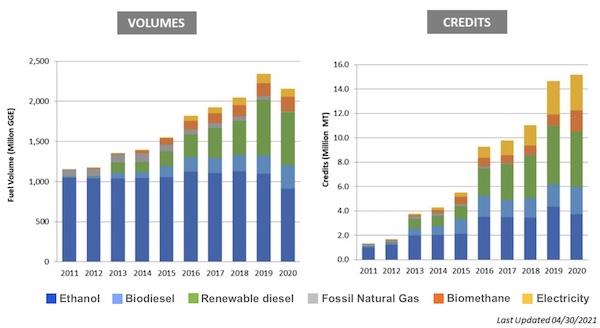
LCFS credits are dependent on the volume of fuel sold, but also on the carbon intensity of the fuel (how it is produced and transported) and how efficiently it is consumed. Source: LCFS dashboard, 2021
There is considerable variation in carbon intensity even for a given type of fuel, depending on how it is produced or transported. For example, a fuel made with waste oil will typically have lower carbon intensity than one made with a virgin product. I think this graph is helpful in showing the variation, despite the demented balloon aesthetic.
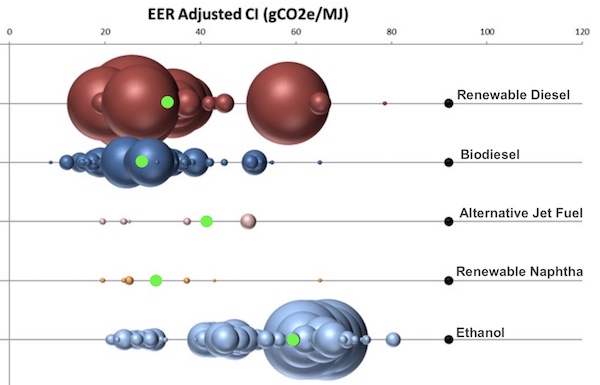
Carbon intensity of different types of liquid fuels in 2020. The position on the x-axis shows the carbon intensity, and the size of the balloon shows the volume sold. The black circle at 92 marks the 2020 LCFS target. The neon green circles mark the average for the fuel type. Source: LCFS dashboard, 2021
The pathway analysis to determine the carbon intensity can be complex. The sample ethanol pathway shown below reflects the fact that not only does growing the corn produce emissions, for example from the use of fertilizer, but so does the fact that land is being converted for agriculture. Credit is given for useful byproducts that result from ethanol production, typically livestock feed.

Source: LCFS overview, 2020
In comparison, the life cycle analysis for biodiesel made from used cooking oil might look like this, with emissions stemming largely from refinement and transportation.

Source: LCFS overview, 2020
The analysis for the electricity that powers EVs is somewhat different. The fuel itself, assuming the grid mix, is fairly carbon intensive (83 gCO2e/MJ in 2020). But because the engines are so efficient, using less than one-third the energy of a traditional engine (3), the analysis is very favorable. And EVs will only get better as the grid gets cleaner.
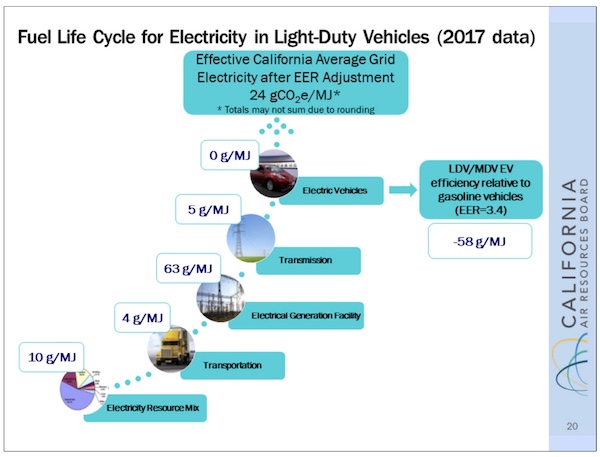
Source: LCFS overview, 2020
It is even possible to have negative carbon intensities when the process for producing the fuel inhibits emissions that would otherwise have occurred. This happens when methane is captured from manure lagoons or from landfills and then used to generate electricity or compressed natural gas. These fuels will have very high reimbursement rates, nearing $10 per gallon-equivalent. As one example, and to get a sense of the complexity of the pathway analysis, check out this pathway application for the New Hope Dairy, which captures methane using a digester and produces electricity for the Sacramento Municipal Utility District, achieving a carbon intensity of -751 gCO2e/MJ (!). You can also view a spreadsheet with many different pathways here.
I am impressed by the amount of work that has gone into the Low Carbon Fuel Standard, and the impact that it is making. We see the results every day in our own neighborhoods, even if we are not aware of it. Indeed, Phillips 66 and Marathon Oil both have proposals to convert their crude oil refineries in Contra Costa County to produce renewable fuels. The market is booming, and it’s because innovative policies like LCFS make California a leader in clean energy.
Notes and References
1. Biodiesel and renewable diesel are not the same thing. Biodiesel is made using a process that results in a fatty acid methyl ester rather than one that results in a hydrocarbon. The chemically inclined can find more information here. The non-chemically-inclined can find more information here.
2. You can find renewable diesel at 76 stations on San Antonio Road in Palo Alto, on El Camino in Menlo Park, and on Broadway in Redwood City. The Valero on Whipple in Redwood City also offers it. There may be others as well.
3. The specific reference for the relative efficiency of electric and gas vehicles comes from page 20 of this CARB report: "EVs in the Light-duty Vehicles (LDV) and Medium-duty Vehicles (MDV) are over three times more efficient than the internal combustion engines (ICE) they replace." But readers may be interested in these two diagrams from fueleconomy.gov, the first for an EV and the second for a gas vehicle.
4. The Low Carbon Fuel Standard also offers credits for programs that reduce the emissions of petroleum-based fuel. That might include installing solar panels to power your oil wells or improving the efficiency of your refinery. LCFS also offers credits for installing fast chargers and hydrogen fuel stations. That is somewhat unintuitive, but they understand that the clean fueling supply needs to exceed demand for a while, in order for demand to ramp up, so the state reimburses the stations for unused capacity.
5. The California Air Resources Board, which administers the LCFS program, provides a good overview of the program here. The program also has a great dashboard here.
6. Valero provides a good overview of renewable diesel here.
Current Climate Data (August 2021)
Global impacts, US impacts, CO2 metric, Climate dashboard (updated annually)
Comment Guidelines
I hope that your contributions will be an important part of this blog. To keep the discussion productive, please adhere to these guidelines or your comment may be moderated:
- Avoid disrespectful, disparaging, snide, angry, or ad hominem comments.
- Stay fact-based and refer to reputable sources.
- Stay on topic.
- In general, maintain this as a welcoming space for all readers.
Comments that are written in batches by people/bots from far outside of this community are being removed.



